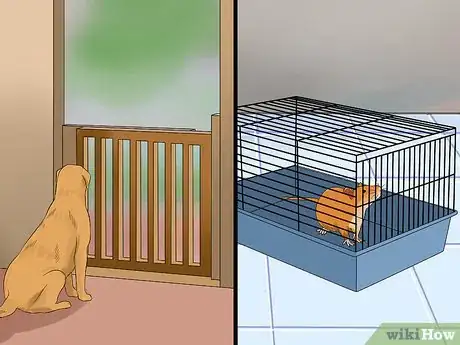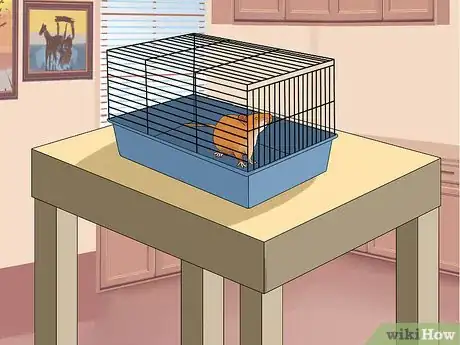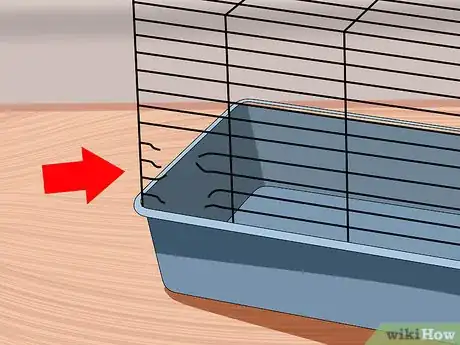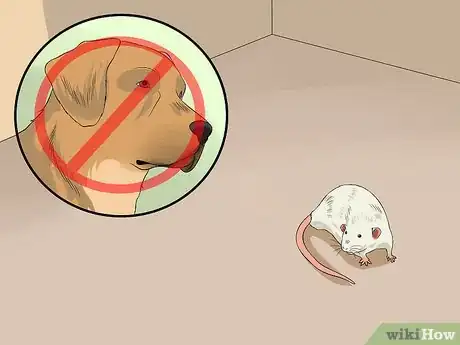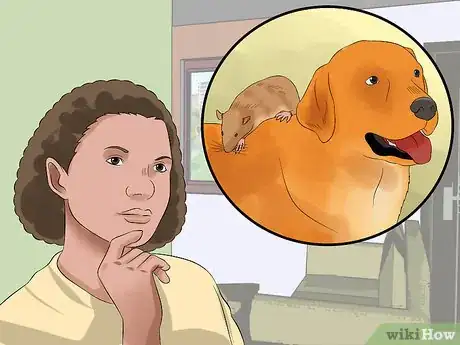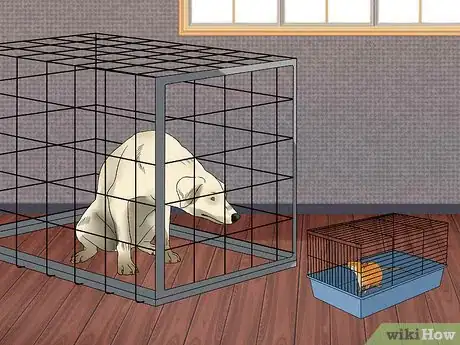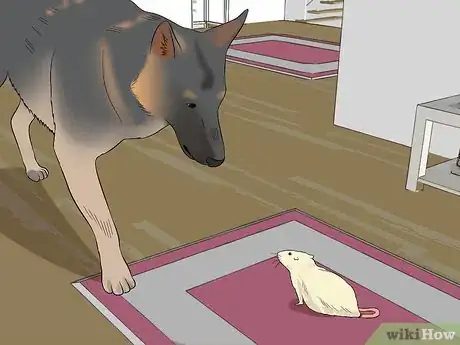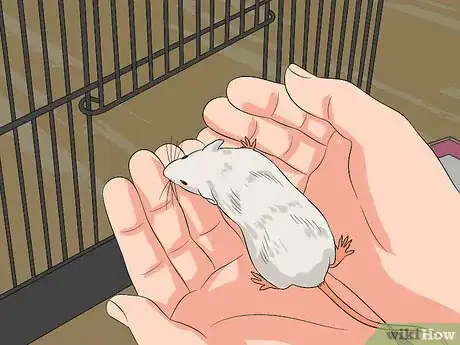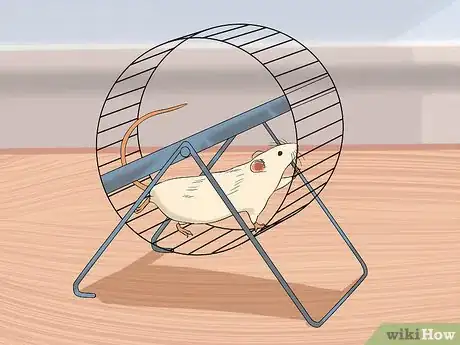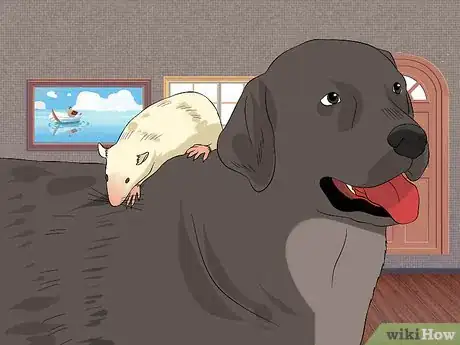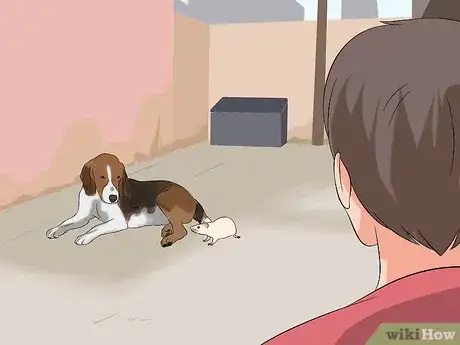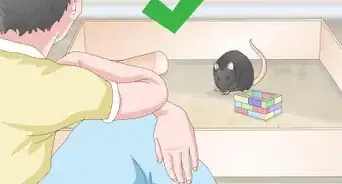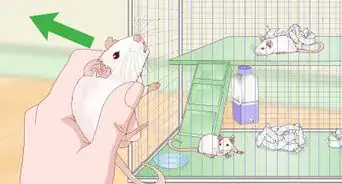This article was co-authored by Pippa Elliott, MRCVS. Dr. Elliott, BVMS, MRCVS is a veterinarian with over 30 years of experience in veterinary surgery and companion animal practice. She graduated from the University of Glasgow in 1987 with a degree in veterinary medicine and surgery. She has worked at the same animal clinic in her hometown for over 20 years.
There are 7 references cited in this article, which can be found at the bottom of the page.
This article has been viewed 20,424 times.
Rats and dogs can both make great pets. However, it can be challenging when it comes to introducing these two pets. If one pet is uncomfortable or nervous around the other, there may be a fight. Thankfully, there are some methods you can use to carefully introduce your pets to one another and keep your rat safe.
Steps
Keeping Your Rat and Dog Separate
-
1Put the cage in a room your dog can't enter. One of the easiest ways you can keep your pet rat safe from your dog is to put its cage in a separate room. This room should be one that has a door you can keep closed to prevent your dog from entering. Consider putting your rat's cage in a room that you can easily keep your dog out of to help keep it safe and secure.[1]
- Even if your rat escapes its cage, being behind the room's closed door will keep your dog and rat from meeting.
- Don't forget to keep the door to the room shut, even if you aren't in the room itself.
- You could also try using a dog-gate or baby-gate to keep your dog out of the room. However, you will need to make sure your rat can't climb over or around the gate when it's out walking around.
-
2Place the cage somewhere that your dog can't reach. If you don't have a room that you can keep your dog out of, you can try placing your rat's cage on a surface that your dog cannot reach. You could try putting the rat's cage on a special high table or a sturdy shelf to keep it up and away from your dog. Look around your home for any elevated places you could use to keep your rat separated from your dog.[2]
- Make sure the space you choose is safe and is capable of supporting the rat's cage.
- It's good to check that your dog won't be able to jump up and reach the cage.
Advertisement -
3Make sure the cage is secure. Rats are clever creatures and may try to escape their cages. A rat that escapes while you are away may have a potentially dangerous encounter with your dog. Always check the rat's cage to make sure that it is sealed properly and there is no chance of your rat sneaking out.[3]
- Check that all doors are securely latched and locked.
- Make sure there are no loose areas of the rat's cage that could come undone.
- Look for any spots that you think your rat might be able to squeeze through and seal them up.
-
4Keep your dog out of the room when your rat is roaming. Whenever you want to let your rat out of the cage for some playtime or exercise, make sure your dog is securely held in another room. Keeping your dog out of the room while your rat plays will help keep your rat safe and allow them time to explore their space.[4]
- Make sure the door to the other room is securely shut.
- If you can't put your dog in another room, try putting them outside or having someone hold them on a leash.
-
5Consider the breed of your dog. Some dogs will do better than others when it comes to introducing them to your pet rat. There are some dog breeds that have been bred to hunt small game and may view your rat as prey. Other dog breeds might get along just fine with your pet rat. Take a look at some of these dog breeds to learn which ones might get along well with your pet rat:[5]
- Australian Shepherd
- Basset Hound
- Bulldog
- Golden Retriever
- Irish Setter
- Pug
Introducing Your Rat to Your Dog
-
1Don't be in a hurry to have your rat and dog become friends. You won't be doing either your dog or your rat any favors by forcing a friendship. You'll need to let the animals bond at their own pace. Pushing a friendship too quickly can result in a potentially dangerous situation for your rat. Always monitor your pets and work at their pace when getting them familiar with one another.[6] [7]
-
2Make sure your rat is comfortable being handled. Before you introduce your rat to your dog, it's a good idea to make sure your rat is comfortable with you holding it. If your rat is nervous about being handled, it may be difficult to control or more ready to start a fight when you introduce it to your dog. Your rat should be totally comfortable with you and with being handled before you attempt any introduction.[8] [9]
- If your rat is new to your home, allow it at least two days to relax and get used to the new environment.
- Whenever you pick your rat up, place one hand under its front legs and the other under its rear legs.
- Your rat will prefer to sit or walk on your arms, instead of being being held.
- Introducing your rat into a large room can make them nervous. Try to let them roam in a smaller room that they can get familiar with.
- Never pick up your rat by the tail.
-
3Introduce your pets through their cages. To help make the first introduction a safe one, try putting both your rat and your dog in their own cage or kennel. Once they are securely placed in their cages, you can bring the cages next to one another and allow your pets to meet each other. The cages will prevent any serious fights or injuries from occurring if one pet becomes nervous or aggressive. [10] [11]
- If you don't have a dog crate, try keeping the rat in its cage and your dog on a leash.
- Your pets will be able to get used to each other's scents by being next to each other.
- Keep introducing your dog and rat in this way to build familiarity before allowing them to meet without their cages.
- Make sure your dog and rat are comfortable near one another before introducing them outside their cages. Neither pet should seem afraid or aggressive towards the other.
-
4Allow your pets to interact outside their cages. If your dog and rat don't seem to mind one another through their cages, try introducing them outside the cage. Keep in mind that this step can be dangerous and you will need to keep a close eye on both your pets. Watch how your dog and rat interact as they meet each other outside their cages for the first time.[12] [13] [14]
- Keep your dog on a leash while introducing it to your pet rat.
- Be ready to hold your dog back if it attempts to bite your rat or becomes aggressive.
- If you are worried about your dog biting your pet rat, try putting a muzzle on your dog.
- It can be a good idea to introduce your rat and dog in a space that neither of them feel is their territory.
- Never leave your pets alone. Even if you feel they are getting along just fine, you will still need to watch them.[15]
-
5Keep a close eye on your pets. While your pets are getting used to one another, you will need to provide constant supervision. You'll want to keep a close eye on their behavior, watching for any signs of aggression or fear from either of them. If you do notice any unwanted behavior, separate them immediately and try again some other time.[16]
- If your dog displays any growling, hair raising, barking, snarling or starts biting, remove your dog immediately.
- If your rat fluffs up its fur, bites, scratches or chomps its teeth, remove your rat and place it back into its cage.
-
6Put the rat back in its cage. Once your pets have had some time together, it's time to return your rat back to its cage. This will give both your pets some time to rest and calm down after their initial encounters. Let your pets rest up and try another introduction at a later time.[17]
Playing with Your Rat and Dog
-
1Allow your rat to come out and play. If you feel that your dog and rat can safely be together, you can try letting your rat out to play. Allow your rat to wander around the room or play with whatever toys you've provided. Your rat will enjoy being with you and your dog as it plays and has fun.[18]
- Many people enjoy building a small obstacle course for their pet rat. You can use old shoe boxes or cardboard tubes to build an engaging playground for your rat.
- Having a box of loose cloth or fabric can give your rat a fun place to burrow in.
- Rats can enjoy running on an exercise wheel.
-
2Let your rat and dog play together. Once your dog and rat have become comfortable with one another, you can let them out to play together. Many rats who are comfortable with dogs will often enjoy climbing around their canine friend or playing tag. Dogs that are friends with rats may try to groom a rat or gently play chase with them. The more time your pets spend together, the more comfortable they will become with one another.[19]
- Make sure your dog doesn't get too excited while playing with your rat. Even though they may be having fun, your dog is much larger than your rat and may accidentally hurt it.
- Your dog and rat will play in whatever way they are comfortable doing. Don't try to force any interaction between them.
- You will mainly be supervising your rat and dog as they play, giving them both lots of love and attention.
-
3Never leave your pets alone. Whenever your rat and dog are playing, you'll want to keep a close eye on them. Although your pets can be fine together, they may act differently if you leave them alone. You'll want to be ready to step in and separate them if an issue arises. Always be in the room that your pets are playing in to help keep them safe.[20]
- Rats and dogs can become very good friends.
- No matter how long your pets get along, you should still watch them while they play.
Expert Q&A
-
QuestionAre pet rats safe?
 Pippa Elliott, MRCVSDr. Elliott, BVMS, MRCVS is a veterinarian with over 30 years of experience in veterinary surgery and companion animal practice. She graduated from the University of Glasgow in 1987 with a degree in veterinary medicine and surgery. She has worked at the same animal clinic in her hometown for over 20 years.
Pippa Elliott, MRCVSDr. Elliott, BVMS, MRCVS is a veterinarian with over 30 years of experience in veterinary surgery and companion animal practice. She graduated from the University of Glasgow in 1987 with a degree in veterinary medicine and surgery. She has worked at the same animal clinic in her hometown for over 20 years.
Veterinarian Rats do carry some diseases that can be passed to people, but pet rats kept in clean conditions are unlikely to carry those diseases. As for rat behavior, as with any animal, if they are socialized young and treated with respect, they are friendly and won't bite.
Rats do carry some diseases that can be passed to people, but pet rats kept in clean conditions are unlikely to carry those diseases. As for rat behavior, as with any animal, if they are socialized young and treated with respect, they are friendly and won't bite. -
QuestionDo pet rats know their owners?
 Pippa Elliott, MRCVSDr. Elliott, BVMS, MRCVS is a veterinarian with over 30 years of experience in veterinary surgery and companion animal practice. She graduated from the University of Glasgow in 1987 with a degree in veterinary medicine and surgery. She has worked at the same animal clinic in her hometown for over 20 years.
Pippa Elliott, MRCVSDr. Elliott, BVMS, MRCVS is a veterinarian with over 30 years of experience in veterinary surgery and companion animal practice. She graduated from the University of Glasgow in 1987 with a degree in veterinary medicine and surgery. She has worked at the same animal clinic in her hometown for over 20 years.
Veterinarian Rats are intelligent and many experts rate their brain power as similar to that of a dog. Following this argument, if a dog recognizes their owner, then so can a rat.
Rats are intelligent and many experts rate their brain power as similar to that of a dog. Following this argument, if a dog recognizes their owner, then so can a rat. -
QuestionWill rat poop hurt a dog?
 Pippa Elliott, MRCVSDr. Elliott, BVMS, MRCVS is a veterinarian with over 30 years of experience in veterinary surgery and companion animal practice. She graduated from the University of Glasgow in 1987 with a degree in veterinary medicine and surgery. She has worked at the same animal clinic in her hometown for over 20 years.
Pippa Elliott, MRCVSDr. Elliott, BVMS, MRCVS is a veterinarian with over 30 years of experience in veterinary surgery and companion animal practice. She graduated from the University of Glasgow in 1987 with a degree in veterinary medicine and surgery. She has worked at the same animal clinic in her hometown for over 20 years.
Veterinarian A healthy rat's poop is unlikely to cause problems for a dog. However, wild rats can carry diseases, of which the most notable is leptospirosis. This can be very serious indeed.
A healthy rat's poop is unlikely to cause problems for a dog. However, wild rats can carry diseases, of which the most notable is leptospirosis. This can be very serious indeed.
Warnings
- Do not let your pets fight. Rats can easily injure your dog and your dog could quickly kill your rat.⧼thumbs_response⧽
- Never leave your rats unsupervised with your dogs.⧼thumbs_response⧽
References
- ↑ https://pethelpful.com/rodents/How-to-Protect-Your-Pet-Rat-from-Dogs
- ↑ https://pethelpful.com/rodents/How-to-Protect-Your-Pet-Rat-from-Dogs
- ↑ https://pethelpful.com/rodents/How-to-Protect-Your-Pet-Rat-from-Dogs
- ↑ https://pethelpful.com/rodents/How-to-Protect-Your-Pet-Rat-from-Dogs
- ↑ http://www.dogbreedinfo.com/petreliability.htm
- ↑ http://www.smallanimalchannel.com/critter-experts/rat/pet-rats-and-dogs-and-cats-1002.aspx
- ↑ http://www.afrma.org/caresheet.htm
- ↑ https://pethelpful.com/rodents/How-to-Protect-Your-Pet-Rat-from-Dogs
- ↑ http://www.ratsrule.com/ratcare.html
- ↑ https://pethelpful.com/rodents/How-to-Protect-Your-Pet-Rat-from-Dogs
- ↑ https://pethelpful.com/rodents/Introducing-a-New-Pet-Rat
- ↑ https://pethelpful.com/rodents/How-to-Protect-Your-Pet-Rat-from-Dogs
- ↑ https://pethelpful.com/rodents/Introducing-a-New-Pet-Rat
- ↑ http://pets.webmd.com/dogs/introducing-new-dog--cat?page=3
- ↑ http://www.afrma.org/caresheet.htm
- ↑ https://pethelpful.com/rodents/How-to-Protect-Your-Pet-Rat-from-Dogs
- ↑ https://pethelpful.com/rodents/How-to-Protect-Your-Pet-Rat-from-Dogs
- ↑ http://www.afrma.org/caresheet.htm
- ↑ http://www.smallanimalchannel.com/critter-experts/rat/pet-rats-and-dogs-and-cats-1002.aspx
- ↑ http://www.afrma.org/caresheet.htm
About This Article
To keep pet rats safe from dogs, close the door to the room with your rat’s cage in it so the dog can’t enter. If you don’t want to restrict your dog’s movements, place the cage on a high table or shelf so your dog can’t reach it. You should also regularly check the cage to make sure it’s secure, since rats are curious creatures that may try to escape. Once you decide that it’s time to introduce your pets, put them both in their cages in the same room so they can see each other without risking injury. Then, let your pets out, but keep your dog on a leash in case it tries to attack your rat. Whenever you take your rats out of their cage, supervise them constantly to make sure your dog doesn’t attack them. For tips from our Veterinary co-author on how to get your rat and dog to play together, keep reading!
